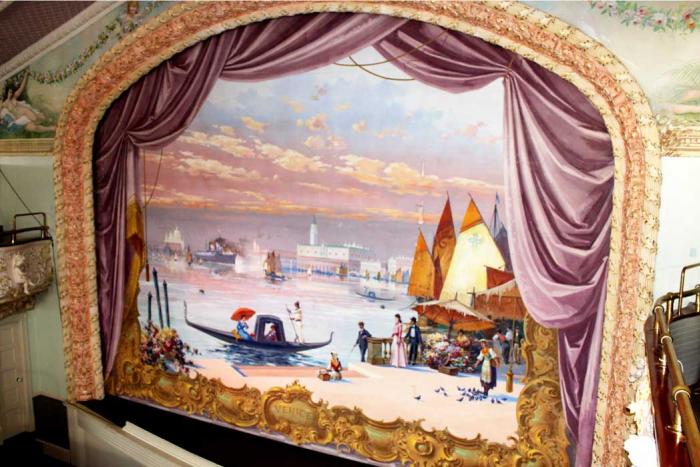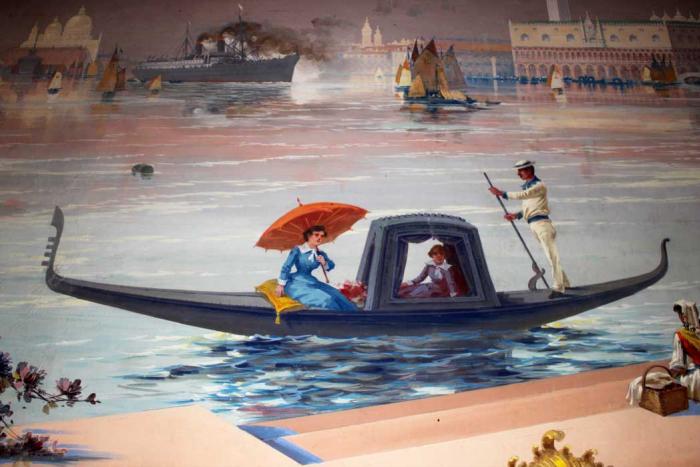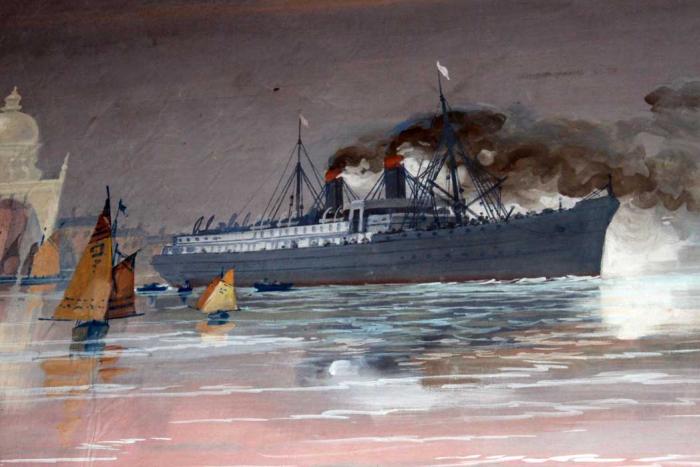Drop curtain, Haskell Opera House
Organization: Haskell Free Library and Opera House (Haskell Free Library Inc.)
Coordinates: www.haskellopera.com
Address: 1 Church Street, Stanstead, QC, J0B 3E2
Region: Estrie
Contact: Matthew Farfan, execdir(a)qahn.org
Description: Drop curtain from the Haskell Opera House that was lowered and raised in between acts during plays and concerts, or at the conclusion of shows.
Year made: Contract dated 1902; Installed in 1904
Made by: Erwin LaMoss
Materials/Medium: Painting on Russian linen
Colours: Multicoloured
Provenance: Boston, USA
Size: 7.6 m x 8.5 m
Photos: Matthew Farfan. Courtesy Haskell Opera House
Drop Curtain, Haskell Free Library and Opera House
Matthew Farfan
For over a century, this famous drop curtain has graced the stage of the Haskell Free Library and Opera House, which was built astride the Canada-U.S. border in Stanstead, Quebec, and Derby Line, Vermont, between 1901 and 1904.

Featuring a splendid, romanticized painting of the harbour of Venice, the curtain is a fine example of turn-of-the-century theatre décor. Painted on Russian linen, and measuring 7.6-metres x 8.5-metres, it is raised and lowered on special occasions, such as on opening and closing nights every concert season. The curtain, along with the backdrop, sets, and other elements of stage scenery and equipment, are believed to be the only surviving examples of the work of the celebrated Vermont-born, Boston theatre artist, Erwin LaMoss (1854-1910). Together, they constitute one of the most complete sets of their kind in North America.
The curtain, sets and stage equipment were created in Boston and transported by train to the border community. Their installation on the stage, which is located on the Canadian side of the Haskell Opera House, took place on May 16, 1904. The event was witnessed by a crowd of onlookers, including the editor of the Stanstead Journal, who reported that “while all expected to see something good none realized the excellence of the scenery and stage equipment until they had seen it.”
Created in the United States for an international facility that is itself a symbol of the amity that exists between two countries, the Haskell’s magnificent curtain is truly one of the treasures of the cross-border community that is Stanstead, Quebec, and Derby Line, Vermont.

The pride of Stanstead, Quebec, and Derby Line, Vermont, the Haskell Free Library and Opera House was constructed deliberately on the boundary line separating Canada from the United States. This remarkable institution has attracted attention from around the world, and has been classified as a historic site by the governments of Canada, the United States and Quebec.
The Haskell Free Library and Opera House was conceived and financed by Martha Haskell, together with her son, Colonel Horace Stewart Haskell, whose wish was to provide the border communities with a centre for learning, cultural enrichment and popular entertainment.
Eastern Townships native Martha Stewart Haskell (1831-1906) was the daughter of American-born parents. She married an American with business interests on the Canadian side of the border. In later life, she lived in Derby Line, Vermont, within sight of the Canadian border. A citizen of the two communities - and the two countries - Martha Haskell envisaged a library and opera house built in her community in such a way as to serve people living on both sides of the line, without their having to pass through customs. This was the genesis of the world’s only international library and opera house. According to a document on the wall of the library, Martha Haskell’s vision was “ample proof of her public spirit and large-hearted generosity.”
Businessman Col. Horace Haskell (1860-1940) oversaw every aspect of the planning, construction, furnishing, management, and, ultimately, the endowment of the institution that bears his family’s name. When Martha Haskell died in 1906, it was Col. Haskell who ensured that the institution would be able to support itself for years to come. After securing a charter in Vermont in 1908 for the library and opera house that he and his mother had founded, Col. Haskell served for years as president of the organization’s board of trustees.
Designed by Stanstead architect James Ball and Gilbert Smith of Boston, and constructed by Nathan Beach, a contractor from Georgeville, the Haskell combines elements of the Queen Anne, Georgian and classical revival styles. Following three years of construction, the opera house opened in 1904, the library the following year.

The Haskell is a curiosity. Nowhere else in the world can one sit in a theatre that is traversed by an international border, and where most of the audience sits in the U.S. to watch a show on a stage in Canada. Nowhere else can one find such an unusual library. The front door is in the U.S., the circulation desk and all of the books are in Canada, and the reading room is international.
The Haskell is notable for the quality of its building materials – local granite on the exterior, and native woods, stained glass, mosaics and tin ceilings on the interior. The atmosphere in the library is luxurious yet restive. There are fireplaces, sofas and artwork. This contrasts with the festive mood in the opera house upstairs, with its proscenium arch, plaster cherubs, murals, and picturesque stage scenery, including, of course, the famous drop curtain by Erwin LaMoss.
The acoustics in the opera house have delighted audiences and performers alike since LaMoss’s curtain was raised for the very first time on opening night on June 7, 1904. Over the past century, the Haskell has hosted an array of performing artists and public speakers. Luminaries such as Arctic explorer Vilhjalmur Stefansson have lectured within its walls. E. Pauline Johnson (Tekahionwake) recited her poetry here. In the early years of the 20th century, minstrel shows and vaudeville were popular. Jazz, blues, folk, bluegrass, rock, classical music, dance, and adult and children’s theatre have all taken centre stage. Generations of performers from both sides of the border have left their signatures on the dressing room walls; these have been carefully preserved to this day.
Today, the Haskell Free Library and Opera House is both an important local institution and a major tourist attraction. A cultural gem, it is a symbol of friendship between two countries – something unique, something to be treasured.
Sources
Josiane Caillet, Une transatlantique à Stanstead, published on Townships Heritage WebMagazine, www.TownshipsHeritage.com
Des Rosiers & Associés Inc., Étude du Décor de scène de l’Opéra Haskell de Rock Island, 1992.
Matthew Farfan, The Making of the Haskell Free Library and Opera House: the Construction Years, 1901-1904, 1999.
Matthew Farfan, A Guide to the Haskell Archives, 1999.
“Édifice Haskell Free Library and Opera House,” Répertoire du patrimoine culturel du Québec, www.patrimoine-culturel.gouv.qc.ca
Haskell Free Library; Haskell Opera House; Haskell Family collections, and Haskell Archives.
To Learn More
Micheal Gillette, Theatre Design and Production, 2000.
Nicole Allardyce, The Development of the Theatre, 1966.
Oscar C. Brockett, The History of the Theatre, 1976.
Author
Matthew Farfan is the Vice President of the Haskell Free Library and Opera House. He is also the Executive Director of the Quebec Anglophone Heritage Network (QAHN).









